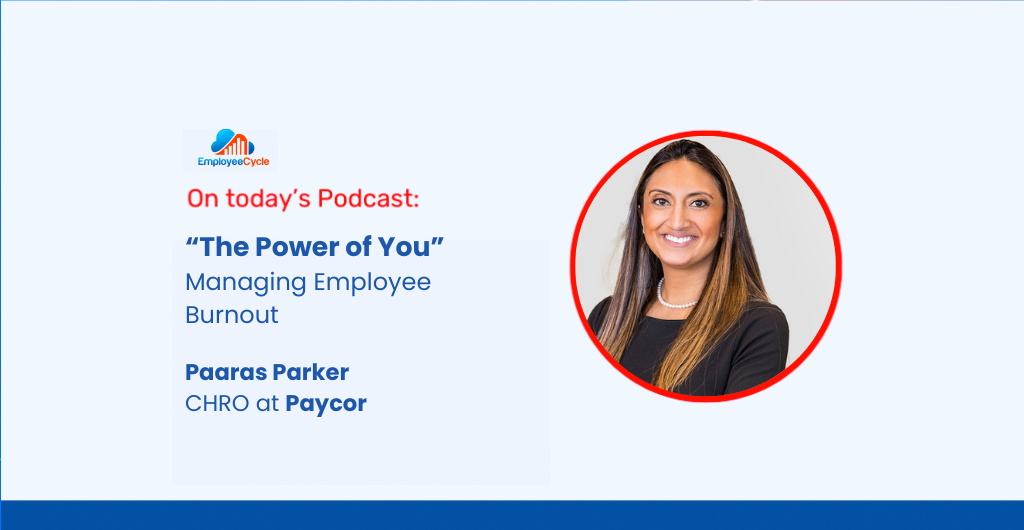Employee burnout remains critical in today’s workplaces, impacting individuals across various roles and hierarchies. In a recent episode of the Employee Cycle podcast, Paaras Parker, CHRO at Paycor, shared invaluable insights on how HR professionals can address and reduce employee burnout. Let’s delve into the key takeaways from this conversation, exploring strategies to combat burnout and foster a healthier work environment.
Recognizing Burnout: Beyond Buzzwords
Paaras Parker eloquently redefined employee burnout, emphasizing its gradual nature rather than a sudden occurrence. It’s a culmination of excessive workload, the pursuit of perfection, and a relentless sense of priorities. Burnout dims the flame gradually until it extinguishes completely, impacting productivity and overall well-being.
HR’s Role: Collaboration and Empowerment
One of the most significant insights Parker shared was the importance of collaborative efforts in mitigating burnout. HR professionals should transcend policy-based roles, positioning themselves as strategic partners. This involves building strong relationships, understanding organizational dynamics, and actively participating in problem-solving. Parker stressed the power of individual agency, encouraging HR leaders to take control while seeking and providing support.
Circle of Control: Aligning Priorities for Solutions
Central to addressing burnout is the concept of a ‘circle of control.’ Parker urged HR professionals to invest time in understanding data accurately and ensuring alignment on problem-solving objectives. Clarity on what needs solving and why lays the foundation for crafting effective solutions. Rather than seeking a perfect solution initially, the emphasis lies on trying various approaches, validating outcomes, and staying agile in response to results.
Success in Collaboration: Shifting Perspectives
A critical shift advocated by Parker lies in defining success not by getting it right the first time but by driving the right outcomes. This necessitates a departure from rigid, company-wide strategies to more agile, experimental approaches. HR leaders should engage in dialogue, align priorities, and test solutions collaboratively, encouraging experimentation and adaptation.
Key Takeaway: Harnessing Personal Power and Support
Paaras Parker’s parting wisdom emphasized the individual’s role in combating burnout. She stressed the importance of recognizing personal agency, asserting that individuals possess significant power every day. However, equally crucial is inviting support, fostering a culture where seeking and providing assistance is encouraged, amplifying collective efforts in combating burnout.
Conclusion
Addressing employee burnout requires a multifaceted approach that embraces collaboration, adaptability, and personal empowerment. Paaras Parker’s insights shed light on HR’s pivotal role in mitigating burnout, emphasizing the need to redefine success, prioritize collaboration, and recognize individual agency.
In closing, Parker’s words echo the essence of collective efforts, encouraging HR professionals and employees alike to champion a workplace culture that values collaboration, self-empowerment, and mutual support to combat burnout effectively.
Centering Helps Prioritization
For individuals without children or different life circumstances, the concept of centering can still apply. It involves identifying what matters most to you in the present moment and using it as your guiding principle. This approach aids in prioritizing tasks, managing conflicting responsibilities, and maintaining a work-life balance.
Paris’s example illustrates that centering can help anyone focus on what’s essential at a given time, ensuring they show up as their best selves in various roles and situations.
Empower, Engage, Influence
In closing, Paris stresses the importance of staying centered to navigate life’s complexities successfully. By doing so, individuals can empower, engage, influence, and uplift the people they interact with, whether it’s at work, with family, or in personal relationships.
The key takeaway from this insightful conversation is that addressing employee burnout is a shared responsibility. It requires organizations to create supportive environments, employees to practice self-awareness and self-care, and everyone to find their center, regardless of their life circumstances.
How to find Paaras Parker and Paycor:
About Paycor
Paycor is a leading provider of comprehensive HR and workforce management solutions designed to streamline and elevate the human resources experience for businesses of all sizes. With a mission to empower organizations to make a difference, Paycor offers innovative tools and services that address the evolving needs of the modern workplace.











